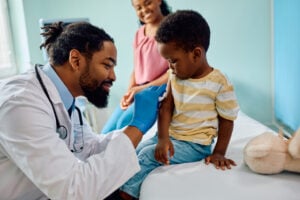Picture the scenario. It’s a beautiful day. You wake up early, ready to conquer the day with a complete list of activities, including yoga, the grocery store, and a child’s birthday party later. You feel like nothing can get in your way . . . until your child wanders into your room at 7 a.m., crying over their bad dream. As any parent, you comfort your child and their big emotions and feel all is well. Until they get mad about the way their pajamas are rubbing on their neck and work themselves into a full tantrum. The clock reads 7:20 a.m. You make it through that battle just in time to put breakfast on the table. Your child storms off because they want eggs with bacon instead of sausage.
It’s now 7:45 am, and you already have to talk them off their third emotional ledge. You find yourself frustrated and questioning why their emotions are so big and your patience so small. Yet you love them wholeheartedly and want to parent them the best you can. You wonder what the remedy for all this emotion is as you head out the door to yoga. At this point, your child is gleefully singing their favorite song at the top of their lungs for everyone to hear as you load them into the car.
Kids and Big Emotions
Children can be full of many things, including life, energy, and emotion. While their zeal for the ice cream truck can sometimes be cute, their passion for needing the dirty, red sippy cup in the dishwasher instead of the clean, blue one in the cabinet can be exhausting. And confusing. And over the top, if you’re honest with yourself.
When you became a parent, you expected to teach them how to ride a bike and hug them when they fall off, but you didn’t expect to have to be their therapist. Managing our kids’ big feelings can be exhausting . . . and confusing!
Why Do Kids Have Big Feelings?
Crying or experiencing distress is a normal way for our kids to express and soothe themselves when they are overwhelmed by big emotions.4,5 Our children aren’t born with the ability to understand, manage, or regulate their feelings; it’s something we need to teach them.6,7 When they are little, they are still learning, so they can become easily frustrated, confused, or even frightened by their emotions. This can exacerbate or make these big feelings even bigger.1 However, not all children have the same capacity for managing their big feelings. The truth is that some kids are more emotional than others.2 Temperament can influence their sociability, flexibility, and reactivity.2 This means some children have bigger and more dramatic reactions to every little thing in life.
There are many names for children with big emotions. Some call them “spirited,” some call them “difficult,” and others call them “dramatic.” Whatever term you embrace, you know it when you have a child with big emotions. You may feel like parenting seems more challenging for you than others. But it isn’t because you are a bad parent. It is harder to work with a child who has high highs and low lows. And it’s okay to admit that.
The ability to regulate and manage their emotions also comes with age and the development of these skills.6,7 Until our kids learn how to manage their emotions, these enormous feelings can be complicated for them. While they learn these skills over time, there are absolutely some ways we can support them to develop adaptive coping strategies.1
How To Help Your Kids With Emotions
So, how do we help these children do that? My favorite technique comes from Dr. John Gottman’s book “Raising an Emotionally Intelligent Child.” In the book, he teaches parents how to become an emotion coach for their child’s emotions in five easy steps. These are Dr. John Gottman’s steps for emotion coaching:8
- Be aware of your child’s emotions.
- Recognize your child’s emotions as a time to teach them and connect.
- Listen with empathy to your child’s feelings.
- Help your child learn to label their emotions with words.
- Set limits when helping your child solve problems or deal with upsetting situations appropriately.
As you can see, Dr. Gottman doesn’t advise you to tell your child to stop feeling what they feel. Instead, as their emotion coach, you can help them understand why they feel those feelings.8 (I recommend reading the book to understand this fantastic method fully.)
Teaching our children the skills to identify their emotions reduces their distress because they understand what is happening to them and why. It also gives them helpful information.8 For instance, when they recognize that the feeling is anger or sadness, they can respond with appropriate coping strategies. This is because different techniques are more or less effective for particular feelings.3
Help Your Child Learn Coping Strategies
It’s essential to support your child to develop different coping strategies to manage their emotions.3 Figure out what works best for your child and help them practice methods like calm breathing, doing star jumps, talking through their emotions, having a hug, or getting some space. Write down the skills, or create a box with items that help them self-regulate, which they can access when needed. Essentially, you want to equip your little one with the confidence to identify and respond to their big feelings.
Putting It Into Practice
Let’s return to the earlier scenario about a sippy cup. As an emotion coach, you might say: “I see you are mad about the sippy cup being dirty. Do you feel frustrated your cup isn’t ready?” After hearing your child’s response and helping them understand which emotion they are feeling, you could say, “I understand you like to use the same cup. I like to drink out of the same cup for my coffee. When I can’t do that, I choose my second-favorite cup. Can you pick another cup you like just like I do?” If your child still chooses to be frustrated, you would stick within your set parameters but assure them you are ready to help as soon as they decide on an alternative cup.
It is also essential that parents do not buy into big emotions and yell back at their children. This will only heighten the situation and lead to harmful short- and long-term effects.9,10 Instead, you must show them how to stay calm and work through problems instead of losing it — as hard as that can sometimes be. Think of them looking into a mirror of what you want them to see.
If you can remain in the mindset of teaching your child how to handle their emotions instead of stopping them from happening, you may find it easier to coach them through these big moments — all 100 of them before noon. Remember along the way that the children with the most emotion inside of them often have the most to offer the world as they mature. So, keep loving and coaching them one patient day at a time.






























